I have produced some notes which I sell at demonstrations and exhibitions, but which are also available to download here as .pdf files (they need Adobe Reader to read them).
Knitting
I don't remember learning to knit, though my grandmother used to treasure a letter from me aged about 5 saying "Please send me more wool because I like knitting!". However I always have some knitting on the go, and have designed various garments over the years (a lot of knitted pictures in the 1980s - see the Knitting sections in the gallery) as well as using knitting in my textile artwork.
I enjoy experimenting with unusual yarns and stitches - I have more problems following a pattern exactly.
I have produced a 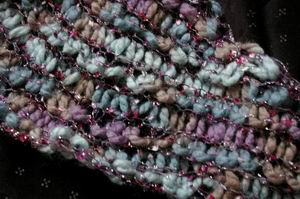 leaflet with
leaflet with 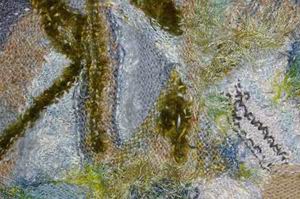 instructions for multicoloured entrelac knitting (as the background for this site), and one which combines instructions for "scribble lace" knitting, pictured on the right here with some notes on how to get "knitting in different directions", as on the left, to lie approximately flat. I sell these at exhibitions and craft fairs, but they are available to download free.
instructions for multicoloured entrelac knitting (as the background for this site), and one which combines instructions for "scribble lace" knitting, pictured on the right here with some notes on how to get "knitting in different directions", as on the left, to lie approximately flat. I sell these at exhibitions and craft fairs, but they are available to download free.
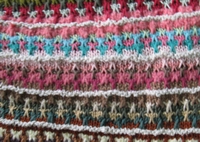 When I exhibited a multicoloured waistcoat
When I exhibited a multicoloured waistcoat 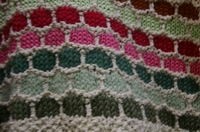 made by my mother there was a lot of interest in the coloured slip stitch patterns she used, so I have produced a leaflet giving details of how to do brick stitch and coloured slip stitch. These stitches look complicated, but they are a relatively simple way to get multicoloured knitting while still using only one colour per row.
made by my mother there was a lot of interest in the coloured slip stitch patterns she used, so I have produced a leaflet giving details of how to do brick stitch and coloured slip stitch. These stitches look complicated, but they are a relatively simple way to get multicoloured knitting while still using only one colour per row.
Dyeing
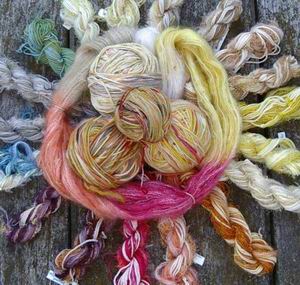 I have done a lot of experimental dyeing with natural (plant) dyes on wool and other animal fibres, and use the resulting yarns for knitting or weaving. I also host a biennial WS&D Guild dyeing picnic, where we boil up a range of plant dyes with wool and other protein fibres as an experimental demonstration. However, if I want cotton or silk dyed for a particular project, or for machine embroidery or tatting, I use chemical dyes. I don't expect to do "production" dyeing - I dye to get small amounts of interesting yarns.
I have done a lot of experimental dyeing with natural (plant) dyes on wool and other animal fibres, and use the resulting yarns for knitting or weaving. I also host a biennial WS&D Guild dyeing picnic, where we boil up a range of plant dyes with wool and other protein fibres as an experimental demonstration. However, if I want cotton or silk dyed for a particular project, or for machine embroidery or tatting, I use chemical dyes. I don't expect to do "production" dyeing - I dye to get small amounts of interesting yarns.
Having demonstrated dyeing with plants, and hosted dyeing days for many years, I have produced some notes on the basic processes for natural dyeing. This will give you an idea of how to get most colours apart from a true blue, which needs indigo or woad, using a complicated chemical process. Although I enjoy the bucket chemistry of indigo/woad dyeing, I am not an expert. For information and advice I suggest you contact Teresinha Roberts of Wild Fibres (see links - natural dyeing), as she has much more experience.
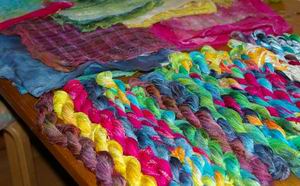 I have also produced instructions for space dyeing using fibre-reactive (procion, Dylon cold)-type dyes - I collect interesting fabrics to experiment with, and use them in the applique/embroidered pictures. I also space dye skeins of mixed cotton/viscose yarns in varying thicknesses for sale at craft fairs and Guild meetings. I don't sell them online as each skein is different and you need to see what you are getting.
I have also produced instructions for space dyeing using fibre-reactive (procion, Dylon cold)-type dyes - I collect interesting fabrics to experiment with, and use them in the applique/embroidered pictures. I also space dye skeins of mixed cotton/viscose yarns in varying thicknesses for sale at craft fairs and Guild meetings. I don't sell them online as each skein is different and you need to see what you are getting.
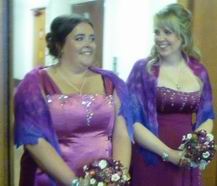 My friend Rachel has written basic instructions for acid dyeing - the type of chemical dyeing which is most useful on wool and protein fibres. This can be used to give space-dyed yarns for knitting or weaving, or you can dye a finished article as I did with these bridesmaids shawls. We often have an acid dyeing workshop alongside the natural dyeing workshop at the Guild dyeing picnic.
My friend Rachel has written basic instructions for acid dyeing - the type of chemical dyeing which is most useful on wool and protein fibres. This can be used to give space-dyed yarns for knitting or weaving, or you can dye a finished article as I did with these bridesmaids shawls. We often have an acid dyeing workshop alongside the natural dyeing workshop at the Guild dyeing picnic.
Knitting patterns
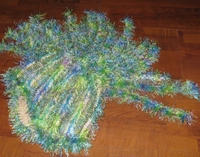 Since I first started the website, I have developed more knitting patterns. I have written out instructions for the dreadlock skiing hats which I made for my son and his friends (see pictures in the gallery under knitted garments). Having led a workshop on Moebius knitting, I've produced some notes on the basic Moebius caston, and developed a pattern for a Moebius hat (also pictured in the Knitted garments section) when I couldn't find a pattern for one online.
Since I first started the website, I have developed more knitting patterns. I have written out instructions for the dreadlock skiing hats which I made for my son and his friends (see pictures in the gallery under knitted garments). Having led a workshop on Moebius knitting, I've produced some notes on the basic Moebius caston, and developed a pattern for a Moebius hat (also pictured in the Knitted garments section) when I couldn't find a pattern for one online. 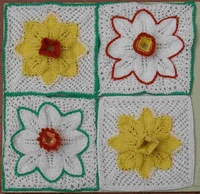 Longer ago, I developed a pattern for a raised flower square for a Knitting & Crochet Guild competition (I was a runner-up). I eventually turned my sample squares into a cushion (see Textile pictures and exhibition entries in the gallery), but I also produced the instructions as a pattern.
Longer ago, I developed a pattern for a raised flower square for a Knitting & Crochet Guild competition (I was a runner-up). I eventually turned my sample squares into a cushion (see Textile pictures and exhibition entries in the gallery), but I also produced the instructions as a pattern.